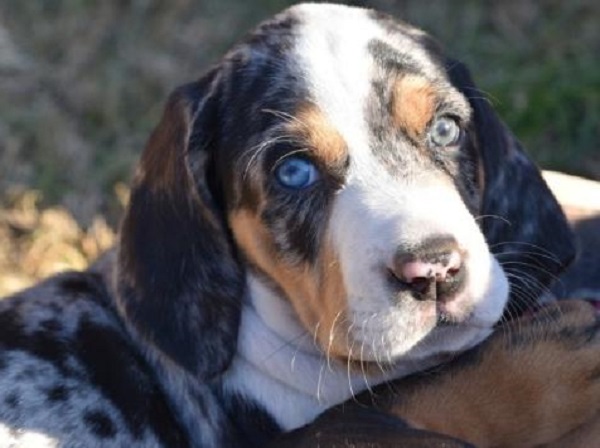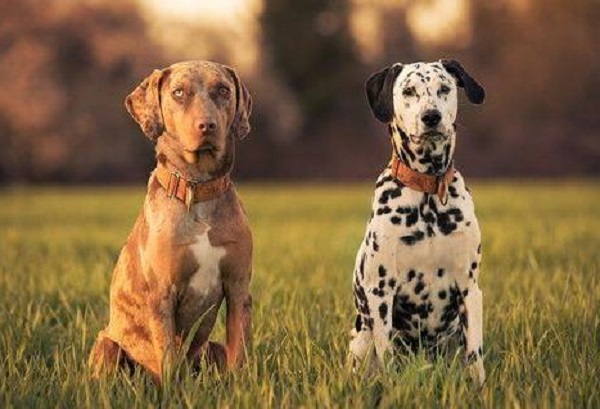Discover the American Leopard Hound—an energetic, protective breed renowned for its striking spotted coat and hunting skills. Also known as the leopard cur, this medium to large dog is characterized by its vocal nature and toughness. In this article, we delve into the essential traits that define the American Leopard Hound, offering a brief yet informative glimpse into this captivating canine’s unique qualities and suitability for active families.

American Leopard Hound History
One of the oldest canine breeds in the Americas, the American Leopard Hound has a mysterious history that involves its ancestors being the dogs of Spanish conquistadors in the New World. There are many ideas about its history, such as possible hybridization with native Mexican dogs and evolution from several hound and herding breeds in the southern United States.
By the early 1700s, the breed had become established in eastern North Carolina. It then moved westward into Tennessee and Kentucky, and then southward into Texas and Oklahoma. In order to protect and advance the American Leopard Cur Breeders Association (ALCBA), enthusiasts like as J. Richard McDuffie, Leroy E. Smith, and A.W. Carter formed the organization in 1960 since the breed was in danger of extinction in the 20th century.
The American Leopard Hound is well-known for being a versatile tree dog that is impressive in its ability to be trained, eager to please, and capable of both hunting and fighting without causing injury. Even though they are excellent hunters, these dogs are loving and protective in the house, particularly with kids.
Features of the Leopard Hound America

Appearance
The American Leopard Hound is a visually striking breed that weighs between 45 and 70 pounds. Its low-maintenance double coat comes in nine official hues, including yellow, red, and black, and has a rough outside and a fine, wooly undercoat. About 60% of them are plain colored, but others have distinctive markings like as brindle, merle, and white tips.
The distinctive round, wide-set eyes of the breed are usually brown or yellow in color, however they may also infrequently have one or two blue eyes. The length of the naturally low-set tail varies, and although some working dogs may have their tails docked, this is still a controversial procedure. Because American Leopard Hounds are uncommon and are often encountered in rural regions, visual identification might be difficult.
It’s crucial to remember that canines with similar appearances, such the Catahoula Leopard Dog, might be confused with American Leopard Hounds. There are, however, some significant distinctions: American Leopard Hounds are classified as hounds, while Catahoulas are bigger and part of the herding group. In spite of their unusual look, American Leopard Hounds are well-known for being friendly toward both humans and other dogs. They may also have a greater prey drive than their Catahoula cousins.
Temperament
The American Leopard Hound is celebrated for its delightful temperament, marked by an eagerness to please, affection, and intelligence.
With a strong desire to be actively involved in their owners’ lives, consistent training and socialization are essential. While not lap dogs, they express love and are particularly protective of children. Their high prey instinct underscores the importance of early socialization to deter chasing behavior. Known for getting along well with other dogs and animals they are raised with, introductions later in life may pose challenges.
Indoors, they are affectionate, but outdoors, their independence and focus on scents make off-leash walks a potential challenge. Embracing and appreciating their inherent hound qualities is crucial for understanding and enjoying the unique temperament of the American Leopard Hound.
Size of American Leopard Hounds
Certain guidelines outline the qualities of the American Leopard Hound breed. Purebred dogs usually weigh between 35 and 75 pounds and have a shoulder height of 21 to 27 inches. They are classified as medium to big dogs. Nonetheless, it’s important to remember that size differences—both greater and smaller—are typical within the breed.
Care for American Leopard Hounds
This very trainable dog is full of activity and has a great desire to please its owner. To preserve the breed’s general wellbeing, optimum care must attend to both its physical and emotional demands.
Diet and Nutrition
Providing a well-balanced diet of food certified by the Association of American Feed Control Officials (AAFCO) is crucial for American Leopard Hounds. Steer clear of overfeeding, since it may exacerbate obesity and other health problems. Consult your veterinarian for advice if you’re unsure about the right diet or serving portions for your dog.
Exercise
Because this breed was developed especially for hunting, it has a tendency to run, chase, and yelp. If hunting isn’t in the cards, finding ways to satisfy these innate tendencies via agility, scent work, or other dog sports is crucial. Ideal for busy families, this breed might get into trouble if it feels lonely or unsatisfied at home. A happy and well-behaved family member depends on having opportunities for both mental and physical stimulation.
Grooming
The American Leopard Hound has a very low-maintenance double coat despite not having long hair. Weekly brushing is part of routine maintenance to get rid of dead hair and take care of little mats. To maintain cleanliness, take occasional showers. To maintain the best possible health and hygiene, regular maintenance procedures like nail trimmings, teeth brushing, and ear cleanings should be carried out for American Leopard Hounds.
Training
The American Leopard Hound is a highly driven breed that enjoys daily mental stimulation and purpose. For their welfare, daily and continuous training is necessary. If you can’t take them on frequent hunts, this active and motivated breed will love participating in sports, obedience contests, and agility training.
The American Leopard Hound’s Lifespan

The average lifetime of an American Leopard Hound is between 10 and 14 years. Individual lifespans may be impacted by a variety of variables, including genetics, general health, food, exercise routines, and the quality of veterinary treatment received, just as with any other dog breed. A balanced and nutritious food, frequent exercise, careful care, and veterinarian check-ups are essential for an American Leopard Hound’s long and healthy life.
Issues related to American Leopard Hound dogs’ health
Even though American Leopard Hounds are typically healthy dogs, owners should be aware of a few health risks. In order to preserve these dogs’ general health, it is essential to be aware of possible problems:
- Breeding Concerns with Merle Color: It is important to use caution when breeding merle-colored dogs since doing so might raise the probability that their progeny will have visual or auditory impairments.
- Periodontal Disease: American Leopard Hounds, like many other dog breeds, may be susceptible to periodontal disease. Frequent dental care is crucial, which includes brushing and veterinarian examinations.
- Ear Infections: American Leopard Hounds are prone to ear infections because of the anatomy and form of their ears. Regular examinations and cleanings of the ears might help avoid problems.
- Parasites: To protect American Leopard Hounds from parasites like fleas and ticks, regular prophylactic treatments are necessary.
- Sensory Impairments: Certain hereditary variables, particularly in merle-colored people, may be linked to an increased risk of blindness or deafness. Veterinary exams on a regular basis may aid in monitoring and treating these problems.
How well does the American Leopard Hound get along with other animals?
Because of their kind and gregarious disposition, American Leopard Hounds get along well with a variety of animals. They are amiable with kids of all ages as long as playing is handled carefully and under supervision, particularly with smaller kids.
With the right introduction, gradual acclimation, and early socialization, the American Leopard Hound may establish harmonious relationships with other pets. Their particular temperament, socialization attempts, and training all affect how well-adapted they are to other species. Early on in life, introducing them to other pets increases the chance of a seamless integration.
But, because of their innately strong prey drive, care should be used, especially around smaller creatures. For the American Leopard Hound and other family pets to get along well, early training, sensible introductions, and continuing monitoring are necessary.
The American leopard hound’s benefits and drawbacks
| Pros | Cons |
|---|---|
| Great with young children | Very vocal |
| Good with other dogs | Requires a lot of mental stimulation |
| Adaptable to hot or cold environments | Needs a lot of exercise |
FAQ
What distinguishes a black-and-tan coonhound from an American leopard hound?
Tan and Black Coonhound:
- Only available in brown and black hues.
- May get to almost double the size of a leopard Hound from America.
- Renowned for being an excellent canine hunter.
The American Leopard Dog
- Displays a wide range of hues and patterns.
- Smaller than the Black and Tan Coonhound, on average.
- Renowned for being a superb hunting dog with a variety of coat patterns.
Can American Leopard Hounds live well in apartments?
No, apartment life is not a good fit for American Leopard Hounds. Apartment living is not the best habitat for this breed, as they need a significant amount of room for play and exercise because to their possible weight of 65 pounds. Additionally, because of their chatty personality, American Leopard Hounds are better suited for families with more room since they may be noisy in small spaces.
Conclusion
The American Leopard Hound is a fascinating breed with a distinctive history and set of traits. It is a smart and loving companion that is perfect for busy families. The breed does need room, exercise, and mental stimulation, so prospective owners should keep that in mind. It is possible to build a satisfying and long-lasting relationship with an American Leopard Hound by acknowledging and fulfilling these criteria.
